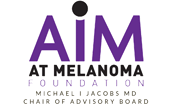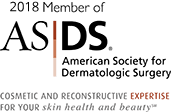Skin cancer is the most common type of cancer in humans. It is thought to be caused by exposure to the sun’s ultraviolet radiation. The lighter the skin color, the more risk of developing precancerous skin lesions and skin cancers. Patients who burn from the sun without tanning are at the higher risk. Patients with dark skin are not completely protected from developing skin cancers, although these lesions often form in different sites on the body from light skin patients. Skin cancers can develop on sun protected skin, so direct sun exposure must not always be needed to form these lesions.
Sunlight protection is still the best prevention in development of precancerous skin lesions, and skin cancers. Early detection and treatment is of paramount importance.
PRECANCEROUS LESIONS:
The most common type of precancerous skin lesions are actinic keratoses and some types of dysplastic nevi.
- ACTINIC KERATOSES: These are usually small, rough papules on sun-exposed skin (scalp, face, ears, upper torso, extensor extremities). They develop over years of sun exposure, and can occur at any age. Patients with keltic skin that usually burns without tanning are particularly at risk. If untreated, a small percentage of actinic keratoses can transform into squamous cell skin cancers.
- DYSPLASTIC NEVI: These are pigmented moles, which can look irregular both to the eye and under the microscope. They are graded in the laboratory into mild, moderate, and severe dysplasia, by the dermatopathology physician. It is possible that some dysplastic nevi are precursors of melanoma skin cancer.
THE MOST COMMON TYPES OF SKIN CANCER INCLUDE THE FOLLOWING:
- BASAL CELL CARCINOMA, the most common type of skin cancer, is most common on the head , ears, neck and sun exposed areas of the body. It can appear as a pink translucent papule, sometimes with little blood vessel telangiectasia on the surface. Color can vary to grey or brown. If it enlarges, it can take on a rough surface or bleed or ulcerate. Basal cell skin cancers are usually local, and if not treated can enlarge and ulcerate, or invade underlying skin structures.
- SQUAMOUS CELL SKIN CANCER, the second most common type of skin cancer, is also most common in sun exposed areas of the body. It can appear as a pink, rough papule, sometimes rapidly enlarging. A small percentage of actinic keratoses can degenerate into squamous cell skin cancers. There is a small chance that squamous cell skin cancers can spread to lymph nodes or other parts of the body.
- MALIGNANT MELANOMA, which occurs less commonly, is a potentially more dangerous type of skin cancer. Approximately half of melanomas develop in pre-existing moles, and have arise in normal appearing skin. The risk of spread is often correlated with the level of skin invasion. Early detection is key.
Other, less common types of skin cancer include Lymphoma, Merkel Cell Carcinoma, Kaposi’s Sarcoma.
Treatment
Treatment for skin cancer can vary widely, depending on the type of cancer, severity, frequency of occurrence, and location on the body. Surgical removal is the treatment of choice, either done in the office, or by Mohs surgery, or excision with possible lymph node screening. Precancerous lesions, such as actinic keratoses, can be treated with liquid nitrogen, laser, photodynamic therapy, fluorouracil and other creams, and other topical modalities. Some of these modalities are also used for prevention.
Early diagnosis is important for the successful treatment of skin cancer, and patients should be screened according to risk. Twice a year skin screenings, for those patients with lots of pigmented skin lesions, and those with a family history of skin cancer. Self examination of one’s skin lesions, on a monthly basis, is a great aid in early diagnosis.
Patients should always consult a dermatologist, when they notice any irregular signs in a pigmented skin lesion, such as changes in color, shape, size, itching, bleeding, or ulceration.
Sunlight avoidance, and use and frequent reapplications of sunscreen with at least an SPF of 30 should be part of everyone’s routine.






